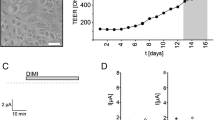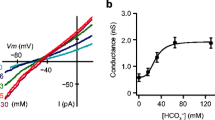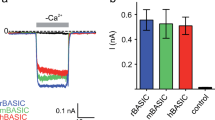Summary
Epithelial cells from the intrahepatic bile duct contribute to bile formation, but little is known of the cellular mechanisms responsible. In these studies, we have characterized the endogenous GTP-binding proteins (G proteins) present in these cells and evaluated their role in regulation of high conductance anion channels. G proteins were identified in purified plasma membranes of isolated bile duct epithelial cells using specific antisera on Western blots, and ion channel activity was measured in excised inside-out membrane patches using patch-clamp recording techniques. In patches without spontaneous channel activity, addition of cholera toxin to the cytoplasmic surface had no effect (n=10). Addition of pertussis toxin caused an activation of channels in 13/34 (38%) attempts, as detected by an increase in channel open probability. Activated channels were anion selective (gluconate/Cl− permeability ratio of 0.17±0.04) and had a unitary conductance of ∼380 pS. Channel open probability was also increased by the nonhydrolyzable GDP analogue guanosine 5′-0-(2-thiodiphosphate) in 8/14 (57%) attempts. In contrast, channel open probability was rapidly and reversibly decreased by the nonhydrolyzable analogue of GTP 5′guanylylimidodiphosphate in 7/9 (78%) attempts. Western blotting with specific antisera revealed that both Gi α−2 and Gi α−3 were present in significant amounts, whereas Gi α−1 and Go α were not detected. These studies indicate that in bile duct epithelial cells, high conductance anion channels are inhibited, in a membrane-delimited manner, by PTX-sensitive G proteins.
Similar content being viewed by others
References
Alpini, G., Lenzi, R., Sarkozi, L., Tavoloni, N. 1988. Biliary physiology in rats with bile ductular hyperplasia. J. Clin Invest. 81:569–578
Alpini, G., Lenzi, R., Zhai, W.R., Slott, P.A., Liu, M.H., Sarkozi, L., Tavoloni, N. 1989. Bile secretory function of intrahepatic biliary epithelium in the rat. Am. J. Physiol. 257:G124-G133
Birnbaumer, L., Codina, J., Yatani, A., Mattera, R., Graf, R., Olate, J., Themmen, A.P.N., Liao, C.-F., Sanford, J., Okabe, K., Imoto, Y., Zhou, Z., Abramowitz, J., Suki, W.N., Hamm, H.E., Iyengar, R., Birnbaumer, M., Brown, A.M. 1989. Molecular basis of regulation of ionic channels by G proteins. Recent Prog. Horm. Res. 45:121–208
Breitwieser, G.E. 1991. G protein-mediated ion channel activation. Hypertension 17:684–692
Brown, A.M. 1990. Ionic channels and their regulation by G protein subunits. Annu. Rev. Physiol. 52:197–213
Brown, A.M., Birnbaumer, L. 1988. Direct G protein gating of ion channels. Am. J. Physiol. 254:H401-H410
Casey, P.J., Gilman, A.G. 1988. G-protein involvement in receptor-effector coupling. J. Biol. Chem. 263:2577–2580
Cerbai, E., Klöckner, U., Isenberg, G. 1988. The α-subunit of the GTP binding protein activates muscarinic potassium channels of the atrium. Science 240:1782–1783
Cohen-Armon, M., Garty, H., Sokolovsky, M. 1988. G-protein mediates voltage regulation of agonist binding to muscarinic receptors: effects on receptor-Na2+ channel interaction. Biochemistry 27:368–374
Fargon, F., McNaughton, P.A., Sepúlveda, F.V. 1990. Possible involvement of GTP-binding proteins in the deactivation of an inwardly rectifying K2+ current in enterocytes isolated from guinea-pig small intestine. Pfluegers Arch. 417:240–242
Farouk, M., Vigna, S.R., McVey, D.C., Meyers, W.C. 1992. Localization and characterization of secretin binding sites expressed by rat bile duct epithelium. Gastroenterology 102:963–968
Goldsmith, P., Rossiter, K., Carter, A., Simonds, W., Unson, C.G., Vinitsky, R., Spiegel, A.M. 1988. Identification of the GTP-binding protein encoded by Gi3 complementary DNA. J. Biol. Chem. 263:6476–6479
Green, N., Alexander, H., Olson, A., Alexander, S., Shinnick, T.M., Sutcliffe, J.G., Lerner, R.A. 1982. Immunogenic structure of the influenza virus hemagglutin. Cell 28:477–487
Hamill, O.P., Marty, A., Neher, A., Sakmann, B., Sigworth, E.J. 1981. Improved patch-clamp techniques for high resolution recording from cells and cell-free patches. Pfluegers Arch. 391:85–100
Inoue, M., Kuriyama, H. 1991. Muscarinic receptor is coupled with a cation channel through a GTP-binding protein in guinea-pig chromaffin cells. J. Physiol. 436:511–529
Inoue, R., Isenberg, G. 1990. Acetylcholine activates nonselective cation channels in guinea pig ileum through a G protein. Am. J. Physiol. 258:C1173-C1178
Ishii, M., Vroman, B., LaRusso, N.F. 1989. Isolation and morphological characterization of bile duct epithelial cells from normal rat liver. Gastroenterology 97:1236–1247
Johnson, G.L., Kaslow, H.R., Bourne, H.R. 1978. Reconstitution of cholera toxin-activated adenylate cyclase. Proc. Natl. Acad. Sci. USA 75:3113–3117
Katada, T., Ui, M. 1982. Direct modification of the membrane adenylate cyclase system by islet-activating protein due to ADP-ribosylation of a membrane protein. Proc. Natl. Acad. Sci. USA 79:3129–3133
Kato, A., Gores, G.J., LaRusso, N.F. 1992. Secretin stimulates exocytosis in isolated bile duct epithelial cells by a cyclic AMP-mediated mechanism. J. Biol. Chem. 267:15523–15529
Kirsch, G.E., Yatani, A., Codina, J., Birnbaumer, L., Brown, A.M. 1988. α-subunit of Gk activated atrial K2+ channels of chick, rat, and guinea pig. Am. J. Physiol. 254:H1200-H1205
Light, D.B., Ausiello, D.A., Stanton, B.A. 1989. Guanine nucleotide-binding protein, α i−3, directly activates a cation channel in rat renal inner medullary collecting duct cells. J. Clin. Invest. 84: 352–356
Light, D.B., Schwiebert, E.M., Fejes-Toth, G., Naray-Fejes-Toth, A., Karlson, K.H., McCann, F.V., Stanton, B.A. 1990. Chloride channels in the apical membrane of cortical collecting duct cells. Am. J. Physiol. 258:F273-F280
Linder, M.E., Gilman, A.G. 1991. Purification of recombinant Gi-α and Go-α proteins from Escherichia coli. Methods Enzymol. 195:202–215
Logothetis, D.E., Kim, D., Northup, J.K., Neer, E.J., Clapham, D.E. 1988. Specificity of action of guanine nucleotide-binding regulatory protein subunits on the cardiac muscarinic K2+ channel. Proc. Natl. Acad. Sci. USA 85:5814–5818
Lynch, C.J., Blackmore, P.F., Johnson, E.H., Wange, R.L., Krone, P.K., Exton, J.H. 1989. Guanine nucleotide binding regulatory proteins and adenylate cyclase in livers of streptozotocin- and BB/Wor-diabetic rats. J. Clin. Invest. 83:2050–2062
Mathis, G.A., Walls, S.A., Sirica, A.E. 1988. Biochemical characteristics of hyperplastic rat bile ductular epithelial cells cultured “on top” and “inside” different extracellular matrix substitutes. Cancer Res. 48:6145–6153
McGill, J.M., Basavappa, S., Fitz, J.G. 1992. Characterization of high-conductance anion channels in rat bile duct epithelial cells. Am. J. Physiol. 262:G703-G710
Moore, D.J., Moore, D.M. 1989. Preparation of mammalian plasma membranes by aqueous two-phase partition. Biotechniques 7:946–958
Mumby, S., Pang, I.-K., Gilman, A.G., Sternweiss, P.C. 1988. Chromatographic resolution and immunologic identification of the α−40 and α−41 subunits of guanine nucleotide-binding regulatory proteins. J. Biol. Chem. 263:2020–2026
Mumby, S.M., Gilman, A.G. 1991. Synthetic peptide antisera with determined specificity for G protein α or β subunits. Methods Enzymol. 195:215–233
Nathanson, M.H., Boyer, J.L. 1991. Mechanisms and regulation of bile secretion. Hepatology 14:551–566
Nelson, D.J., Tang, J.M., Palmer, L.G. 1984. Single channel recordings of apical membrane chloride conductance in A6 epithelial cells. J. Membrane Biol. 80:81–89
Ross, E.M., Gilman, A.G. 1977. Resolution of some components of adenylate cyclase necessary for catalytic activity. J. Biol. Chem. 252:6966–6969
Schlichter, L.C., Grygorczyk, R., Pahapill, P.A., Grygorczyk, C. 1990. A large, multiple-conductance chloride channel in normal human T lymphocytes. Pfluegers Arch. 416:413–421
Schneider, G.T., Cook, D.I., Gage, P.W., Young, J.A. 1985. Voltage sensitive, high-conductance chloride channels in the luminal membrane of cultured pulmonary alveolar (type II) cells. Pfluegers Arch. 404:354–357
Schwiebert, E.M., Light, D.B., Fejes-Toth, G., Naray-Fejes-Toth, A., Stanton, B. 1990. A GTP-binding protein activates chloride channels in a renal epithelium. J. Biol. Chem. 265:7725–7728
Sirica, A.E., Sattler, C.A., Cihla, H.P. 1985. Characterization of a primary bile ductular cell culture from the livers of rats during extrahepatic cholestasis. Am J. Pathol. 120:67–78
Sirica, A.E., Mathis, G.A., Sano, N., Elmore, L.W. 1990. Isolation, culture, and transplantation of intrahepatic biliary epithelial cells and oval cells. Pathobiology 58:44–64
Sirica, A.E., Cihla, H.P. 1984. Isolation and partial characterization of oval and hyperplastic bile ductular cell-enriched populations from the livers of carcinogen and noncarcinogen-treated rats. Cancer Res. 44:3454–3466
Slott, P.A., Liu, M.H., Tavoloni, N. 1990. Origin, pattern, and mechanism of bile duct proliferation following biliary obstruction in the rat. Gastroenterology 99:466–477
Sunyer, T., Monastirsky, B., Codina, J., Birnbaumer, L. 1989. Studies on nucleotide and receptor regulation of Gi proteins: Effects of pertussis toxin. Mol. Endocrinol. 3:1115–1124
Tilly, B.C., Kansen, M., van Gageldonk, P.G.M., van den Berghe, N., Galjaard, H., Bijman, J., de Jonge, H.R. 1991. G-proteins mediate intestinal chloride channel activation. J. Biol. Chem. 266:2036–2040
Uhing, R.J., Polakis, P.G., Snyderman, R. 1987. Isolation of GTP-binding proteins from myeloid HL-60 cells. J. Biol. Chem. 262:15575–15579
Yatani, A., Codina, J., Imoto, Y., Reeves, J.P., Birnbaumer, L., Brown, A.M. 1987. A G protein directly regulates mammalian cardiac calcium channels. Science 238:1288–1292
Yatani, A., Mattera, R., Codina, J., Graf, R., Okabe, K., Padrell, E., Iyengar, R., Brown, A.M., Birnbaumer, L. 1988. The G protein-gated atrial K2+ channel is stimulated by three distinct Gi α-subunits. Nature 336:680–682
Author information
Authors and Affiliations
Additional information
We gratefully acknowledge the assistance of Marwan Farouk, M.D. in the preparation of bile duct epithelial cells, Lucy Seger in the identification of the G proteins, C.F. Starmer in channel analysis, and P.J. Casey for the gift of bacteria expressing the different G-protein α-subunits. This work was supported in part by grants from the National Institutes of Health DK43278 (to J.G.F.), DK42486 (to T.W.G.), and DK07568 (to J.M.M.); American Gastroenterological Association/G.D. Searle Research Scholar Award (to J.G.F.) and an American Gastroenterological Association Advanced Research Training Award (J.M.M.).
Rights and permissions
About this article
Cite this article
McGill, J.M., Gettys, T.W., Basavappa, S. et al. GTP-binding proteins regulate high conductance anion channels in rat bile duct epithelial cells. J. Membarin Biol. 133, 253–261 (1993). https://doi.org/10.1007/BF00232024
Received:
Revised:
Issue Date:
DOI: https://doi.org/10.1007/BF00232024




